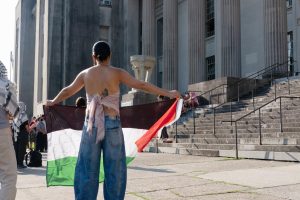Tulane students dressed in racist caricatures, are we surprised?
October 30, 2019

Saturday, Oct. 26th, five days before Halloween, Tulane students have already begun their celebrations in full swing. You cannot walk through campus without spotting a group of students in a variety of costumes and, in more cases than not, at least one in an extremely offensive and racist costume.
This past Saturday, a group of friends are sitting on their porch on Lowerline Street when they see three people — apparently Tulane students — walking down their street, two dressed in Arab thobes and shemaghs and one dressed as a pilot. The joke of these students’ costumes was that they dressed up as 9/11.
Later that night, I am at a house party, and a group of three white boys drunkenly stagger down the stairs, all dressed in Mexican charro outfits and sombreros as “the three amigos.” Disgusted, I take a minute to decompress in the bathroom. Scrolling through my Instagram feed, I see a group of my own friends at Voodoo Fest, four of whom are wearing traditional Japanese kimonos as cardigans. I wish I was lying about these experiences.
The form of racism that is appropriating other cultures to mock them has found a comfortable home at Tulane University. I remember my freshman year when one of the white guys on my floor raided my closet to find the speckled purple and blue Kurta Paijama my parents had gifted me for Eid Ul-Adha. He then asked if he could wear it on Halloween to be Aladdin.
Reminder: If you dress up in a costume that is racist, xenophobic, ableist, islamophobic or relies on any other harmful system of oppression this Halloween, you unequivocally get sent to the Bad Place when you die. Yay!
— Janet (@Janet12358W) October 27, 2019
The dress and wear of non-white cultures are never free costume game for the white colonizer community. When a white person wears the cultural dress of a nonwhite culture for Halloween — or any other occasion — it is an act of immense racist disrespect and blatant cultural theft.
The Arab thobes and shemaghs represent purity and pride in the face of God. When these traditional garments are worn, they represent a closenss to Islam, bringing people out of sinful aspects of their daily life to invest into a spirtuality of peacefulness. Charro outfits are traditionally only worn by mariachis at happy events and times of celebration. Donning the apparel and calling yourself a Mexican perpetuates an outdated racist caricature of who Mexicans are. The Japenese kimono is a symbol of history that incorporates generations of national struggle to represent beauty in dress.
White people, the cultural items of dress that you think characterize the identity of nonwhite people are the tokens and symbols of our culture that have been able to withstand imperialism, colonialism and the European erasure of our communities. When you wear these items, you are just resurrecting a long, bloody history of colonialism, stealing our culture for your own selfish benefit.
As each Halloween passes, I fear that my purple and blue speckled Kurta Paijama will no longer be celebrated as a dress of honor in South Asian culture, but be sold at Party City as an “Aladdin costume.” I set aside my paijama for weddings, religious holidays, cultural celebrations. Each time I step out into American society donning that dress, I fear being the victim of a hate crime, someone attacking me because they are threatened by a culture other than their own. White people can walk out on Halloween in my Kurta Paijama — when it is convenient from them — and wake up the next day, full restoration of white privilege and all.
Imagine someone you do not know taking one of the most sacred items in your life, maybe a dress or a sweater, given to you by a close recently-passed relative, wearing that piece all Halloween weekend, getting drunk in it, wearing it as a costume and laughing at it as a joke.
Two years ago, during Halloween weekend, I stood in line at The Boot. In front of me, there was a white boy wearing a bright purple traditional African dashiki. When I confronted him about cultural offense, he had told me his Black friend said it was okay for him to wear it, so he did. Just because you have permission from one person, out of an entire race, to do something like this never means you should.
Culture is fundamental to who we are and that is in large part expressed by how we dress. To take something of another culture that is not yours is simply theft. And this is not only a problem for white people. People of color are well capable of stealing from cultures that they do not belong to. We all need to learn that someone else’s culture is never our costume.
After Jess Galloway and Nile Pierre’s Voodoos and Don’ts was published two years ago, I was really counting on this year being the year The Hullabaloo would not have to write a story about this, but as proven by the costumes I saw this weekend, I was disappointingly wrong.
Get it right, Tulane. We are tired.








m • Nov 15, 2019 at 12:38 pm
I would also like to point out that wearing the religious clothing of ANY religion is wrong. Dressing as a jewish rabbi or as a catholic nun is also NEVER okay.
L. • Nov 1, 2019 at 2:31 pm
We are TIRED!!!